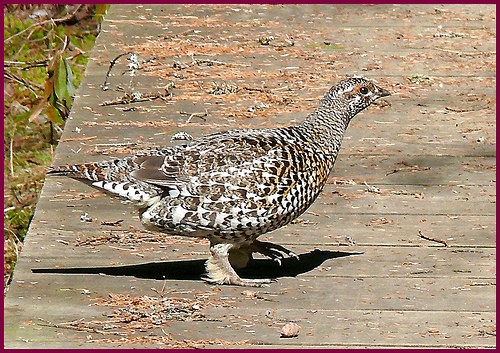Spruce Grouse
A species of Spruce and Siberian Grouses Scientific name : Canachites canadensis Genus : Spruce and Siberian Grouses
Spruce Grouse, A species of Spruce and Siberian Grouses
Botanical name: Canachites canadensis
Genus: Spruce and Siberian Grouses
Content
Description People often ask General Info
Description
Spruce grouse are 38–43 cm (15–17 in) long; males weigh 550–650 g (19–23 oz) and females 450–550 g (16–19 oz). The spruce grouse has a wingspan range of 21.5-22.6 in (54.5-57.5 cm). Races vary slightly in plumage, especially in the tail pattern and in the extent of white on the underparts, but in general adult males are mainly grey above and black below, with white spots along the side, and a red patch of bare skin over the eye called the "eyebrow comb". This red eyebrow comb, should not be confused by a similar yellow marking found on other species of grouse including, but not limited to, sharp-tailed and dusky grouse. Adult females are mottled brown (red morph) or mottled grey (grey morph) with dark and white bars on the underparts. Juveniles resemble females. Females may be confused with ruffed grouse but they have a dark tail with a pale band at the end (while the reverse is true in ruffed grouse) and they do not erect their crown feathers when alarmed the way ruffed grouse do. 
Size
38-43 cm (15-17 in)
Colors
Brown
Black
Red
Gray
White
Life Expectancy
5–13 years
Nest Placement
Ground
Clutch Size
4 - 9 eggs
Incubation Period
1 brood
Number of Broods
20 - 23 days
Feeding Habits
Spruce Grouse consumes mainly conifer needles year-round, preferring pines and spruces, which they clip from trees. In warmer months, they also eat berries, green plants like blueberry leaves, fungi, insects, and snails. Females and chicks forage on the ground for fungi and arthropods, crucial for chick development. The birds adjust their digestive system seasonally, enlarging the caeca and ventriculus in winter for needle digestion. They store needles in the crop overnight and consume grit for digestion aid.
Habitat
Spruce Grouse primarily inhabits dense coniferous forests across North America, ranging from lowland bogs to montane regions. Preferring altitudes where trees stand 20–50 feet high, spruce Grouse is adapted to varied climatic conditions of northern latitudes. Vegetation in these habitats typically consists of pine, spruce, fir, and in some areas, larch, jack pine, or deciduous woods during autumn dispersal. Spruce Grouse favors young, regenerating forests, particularly after fire or pest outbreaks. Dense undergrowth and open forest patches are crucial for protection and sustenance, especially for females with chicks.
Nest Behavior
The female spruce Grouse chooses the nest site and constructs it. Nesting activities, including egg-laying, typically occur during spring-summer. Both parents may be involved in parental care, with the female primarily incubating and the male sometimes guarding.
Nest Characteristics
Spruce Grouse's nests are found on the ground, in depressions at the base of trees with concealing branches. They are made from dead needles, leaves, and sometimes lined with the bird's breast feathers, creating a bowl-like shape.
Dite type
Herbivorous
People often ask
General Info
Feeding Habits
Bird food type
Sounds
Call
Recording location: United States
Behavior
Spruce Grouse are known for their discreet presence, quietly traversing the evergreen forest floors or dirt paths. They adeptly blend into the canopy when foraging, thanks to their dark plumage. Unlike other birds, spruce Grouse are more often seen walking in trees rather than flying, unless startled or engaging in mating displays. They are territorial, with both sexes defending their respective areas—females typically mate with one male, whereas males might court multiple partners. These birds have a notable flutter-flight mating ritual, where males create a whirring noise with an occasional wing clap. During courtship, males put on an elaborate display, puffing up plumage and tail feathers to entice females. Although spruce Grouse may form small flocks in fall, by spring, they are usually solitary, a trait that can persist throughout the year.
Distribution Area
As a specialist of the taiga, the spruce grouse is found throughout Canada. In the United States, it is present in Alaska, northern New England, northern Michigan, northeastern Minnesota, northern Wisconsin and the montane coniferous forests of Montana, Idaho, Maine, Oregon, and Washington. Spruce grouse are always associated with conifer-dominated forests, be they pine, spruce, or fir. They seem to prefer young successional stands. In summer they can be found near rich understory of blueberries and other shrub, and in winter they prefer denser stands. 
Species Status
Not globally threatened.
